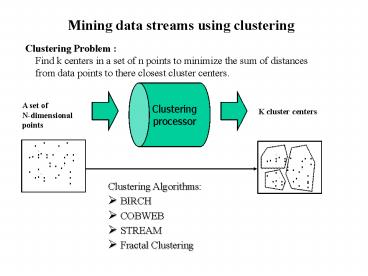Mining data streams using clustering - PowerPoint PPT Presentation
1 / 8
Title:
Mining data streams using clustering
Description:
K cluster centers. Clustering Problem : Find k centers in a set of n points to minimize the ... Local clustering: Assign each point in Sito its closest center ... – PowerPoint PPT presentation
Number of Views:74
Avg rating:3.0/5.0
Title: Mining data streams using clustering
1
Mining data streams using clustering
Clustering Problem Find k centers in a set
of n points to minimize the sum of distances
from data points to there closest cluster centers.
Clustering processor
A set of N-dimensional points
K cluster centers
.
.
.
.
.
.
.
.
.
.
.
.
.
.
.
.
.
.
.
.
.
.
.
.
.
.
.
.
.
.
.
.
.
.
.
- Clustering Algorithms
- BIRCH
- COBWEB
- STREAM
- Fractal Clustering
2
K-median algorithm
- Problem Definition
- Given D a set of n points in a metric space,
choose k medians - so as to minimize the assignment cost
- the sum of (squared) distances from points to
nearest centers. - Given m data points. Find k clusters of these
points such that the sum - of the 1-norm distances from each point to the
closest cluster center is - minimized.
Two-step algorithm STEP 1 For each set of M
records, Si, find O(k) centers in S1, , Sl
Local clustering Assign each point in Sito its
closest center STEP 2 Let S be centers for S1,
, Sl with each center weighted by number of
points assigned to it. Cluster S to find k
centers
3
Decision trees
- One of the most effective and widely-used
classification methods - Induce models in the form of decision trees
- Each node contains a test on the attribute
- Each branch from a node corresponds to a possible
outcome of the test - Each leaf contains a class prediction
- A decision tree is learned by recursively
replacing leaves by test nodes, starting at the
root
4
Hoeffding trees
- A classification problem is defined as
- N is a set of training examples of the form (x,
y) - x is a vector of d attributes
- y is a discrete class label
- Goal To produce from the examples a model yf(x)
that predict the classes y for future examples x
with high accuracy
- Hoeffding Bound
- Consider a random variable a whose range is R
- Suppose we have n observations of a
- Mean
- Hoeffding bound states
- With probability 1- ?, the true mean of a is at
least - , where
5
VFDT(Very Fast Decision Tree)
- A decision-tree learning system based on the
Hoeffding tree algorithm - Split on the current best attribute, if the
difference is less than a user-specified
threshold - Wasteful to decide between identical attributes
- Compute G and check for split periodically
- Memory management
- Memory dominated by sufficient statistics
- Deactivate or drop less promising leaves when
needed - Bootstrap with traditional learner
- Rescan old data when time available
- Scales better than pure memory-based or pure
disk-based learners
6
CVFDT (Concept-adapting VFDT)
- Extension of VFDT
- Same speed and accuracy as VFDT
- Source producing examples may significantly
change behavior. - In some nodes of the tree, the current splitting
attribute may not be the best anymore - Expand alternate trees. Keep previous one, since
at the beginning the alternate tree is small and
will probably give worse results - Periodically use a bunch of samples to evaluate
qualities of trees. - When alternate tree becomes better than the old
one, remove the old one. - CVFDT also has smaller memory requirements than
VFDT over sliding window samples.
7
Experiment resultsVFDT Vs CVFDT
- CVFDT not use too much RAM
- D50, CVFDT never uses more than 70MB
- Use as little as half the RAM of VFDT
- VFDT often had twice as many leaves as the number
of nodes in CVFDTs HT and alternate sub trees
combined - Reason VFDT considers many more outdated
examples and is forced to grow larger trees to
make up for its earlier wrong decisions due to
concept drift
8
Association Rules
- Finding frequent patterns, associations,
correlations, or causal structures among sets of
items or objects in transaction databases,
relational databases, and other information
repositories. - Lossy Algorithm
- Sticky algorithm
- Features of the algorithms
- Sampling techniques are used
- Frequency counts found are approximate but error
is guaranteed not to exceed a user-specified
tolerance level - For Lossy Counting, all frequent items are
reported - Sticky Sampling is non-deterministic, while Lossy
Counting is deterministic - Experimental result shows that Lossy Counting
requires fewer entries than Sticky Sampling































